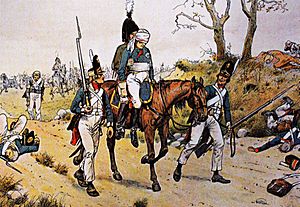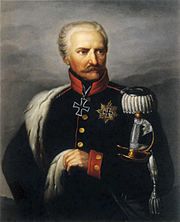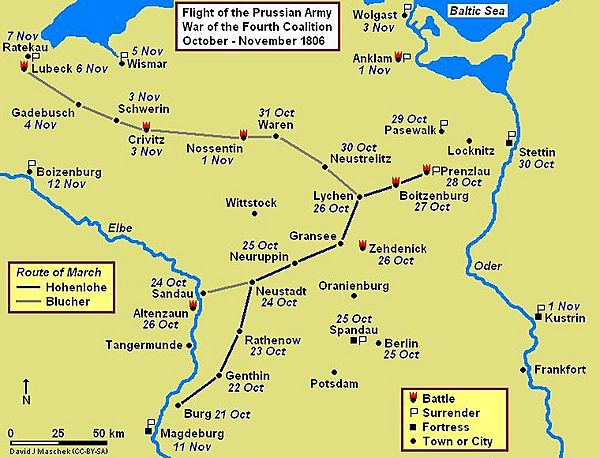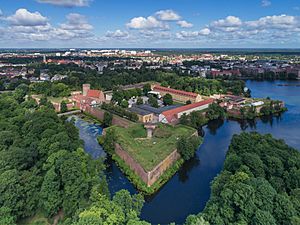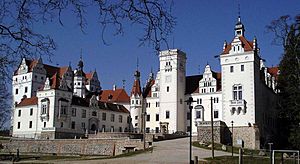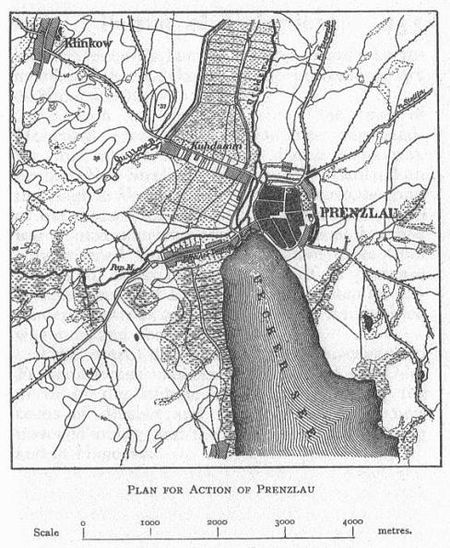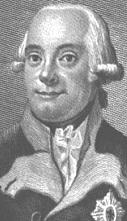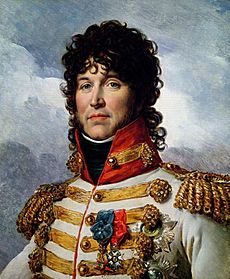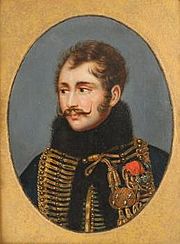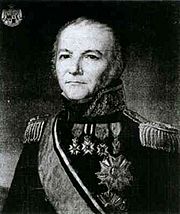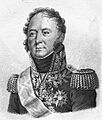Battle of Prenzlau facts for kids
Quick facts for kids Battle of Prenzlau |
|||||||
|---|---|---|---|---|---|---|---|
| Part of the War of the Fourth Coalition | |||||||
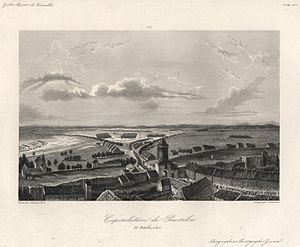 Capitulation of Prenzlau by Simeon Fort (1793–1861). |
|||||||
|
|||||||
| Belligerents | |||||||
| Commanders and leaders | |||||||
| Strength | |||||||
| 12,000, 12 guns | 10,000-12,000, 64 guns | ||||||
| Casualties and losses | |||||||
| Slight | 10,000, 64 guns | ||||||
The Battle of Prenzlau was a major event during the War of the Fourth Coalition. On October 28, 1806, French cavalry and some infantry, led by Marshal Joachim Murat, caught up with a retreating Prussian army. This Prussian force was commanded by Frederick Louis, Prince of Hohenlohe-Ingelfingen.
The battle took place near Prenzlau, a town about 90 kilometers north of Berlin in Brandenburg, Germany. After some fighting, Prince Hohenlohe surrendered his entire army to Murat. This was a significant victory for the French.
After their big defeat at the Battle of Jena-Auerstedt on October 14, the Prussian armies were running north. They were trying to escape Emperor Napoleon I of France's powerful army. The Prussians crossed the Elbe River and headed northeast, hoping to reach safety behind the Oder River.
Napoleon sent part of his army east to capture Berlin. The rest of his forces chased the Prussians. From Berlin, Murat moved north with his cavalry. He wanted to cut off Prince Hohenlohe's retreat. After smaller fights on October 26 and 27, Murat reached Prenzlau. He was right behind Hohenlohe's army.
During the fighting at Prenzlau, several Prussian units were captured. Murat then tricked the discouraged Hohenlohe into surrendering. He claimed the Prussians were completely surrounded by a huge French army. In reality, only Murat's cavalry and a small group of infantry were there. In the days that followed, the French convinced more Prussian forces to surrender. Another Prussian army, led by Gebhard Leberecht von Blücher, turned northwest towards Lübeck when their path was blocked.
Contents
What Led to the Battle of Prenzlau?
The Big Battle of Jena-Auerstedt
In October 1806, Napoleon's huge army of 180,000 soldiers invaded Electorate of Saxony. They marched through the Franconian Forest. His troops were organized into large groups, including the Imperial Guard and cavalry.
The Prussian and Saxon armies were divided into three main groups. One was led by Charles William Ferdinand, Duke of Brunswick. Another was under Frederick Louis, Prince of Hohenlohe-Ingelfingen. The third was led by Ernst von Rüchel and Gebhard Leberecht von Blücher.
On October 14, the major Battle of Jena-Auerstedt took place. Napoleon's 96,000 soldiers attacked Hohenlohe's and Rüchel's 53,000 troops at Jena. At the same time, Brunswick's 49,800 soldiers fought against Marshal Louis Davout's 26,000 troops at Auerstedt. The Prussian armies were badly defeated in both battles. Brunswick's army lost 13,000 soldiers and many cannons. Hohenlohe and Rüchel lost up to 25,000 soldiers.
The Prussian Retreat Begins
After the defeat, many Prussians surrendered. At the Capitulation of Erfurt on October 16, over 10,000 Prussians gave up their weapons. This was the first of many unexpected surrenders.
Prince Hohenlohe, Friedrich Adolf, Count von Kalckreuth, and Blücher led the remaining Prussian forces. They marched north through the Harz Mountains. Marshal Nicolas Soult and Marshal Joachim Murat chased them closely. On October 17, Marshal Jean-Baptiste Bernadotte defeated another Prussian group at the Battle of Halle.
By October 20, Hohenlohe and other survivors reached Magdeburg. Murat demanded the city's surrender. Hohenlohe refused, but a French officer was allowed inside. He reported that Hohenlohe's main army was still there and in great confusion. Meanwhile, the French captured important bridges and gunpowder supplies.
Chasing the Prussians East of the Elbe
Leaving some troops to surround Magdeburg, Napoleon ordered his army to march towards Berlin. Napoleon even visited the tomb of Frederick the Great at Potsdam. He took Frederick's sword and other items as trophies.
Hohenlohe's army left Magdeburg on October 21. They were ordered by King Frederick William III of Prussia to march to the Oder River. Hohenlohe left 9,000 soldiers in Magdeburg, but many more were left behind by mistake. His main army reached Genthin on October 22 and Rathenow on October 23. To find food, he split his army into smaller groups.
On October 24, Blücher crossed the Elbe River. Another Prussian general, Christian Ludwig von Winning, took over command from Karl August, Grand Duke of Saxe-Weimar-Eisenach. Hohenlohe reached Neustadt an der Dosse. He sent a group under General Christian Ludwig Schimmelpfennig to protect his right side. This group was to keep the French from stopping their march to Stettin on the Oder River. Blücher was put in charge of Hohenlohe's rear guard.
The old Spandau fortress fell to the French on October 25. The French rushed the gate while the Prussian commander was still talking about surrender terms. They captured 71 cannons and 920 soldiers.
On October 25, Davout's French army marched through Berlin in victory. That evening, Hohenlohe's main army was between Neuruppin and Lindow. Blücher's rear guard was at Neustadt. Napoleon sent Murat and Marshal Jean Lannes north from Berlin to stop Hohenlohe.
On October 26, French cavalry attacked Schimmelpfennig's 1,300 Prussian troops at Zehdenick. The Prussians fought back at first. But more French cavalry arrived and nearly destroyed a Prussian cavalry regiment. Schimmelpfennig's damaged force fled towards Stettin. Because of this, Hohenlohe changed his route, going further north through Lychen.
On October 27, Hohenlohe's army neared Boitzenburg. They hoped to find food at a manor house called Schloss Boitzenburg. But French cavalry had already arrived and were looting the estate. It took Hohenlohe's advance guard three hours to drive them out. Murat heard the fighting and rushed north with more cavalry. South of Boitzenburg, some Prussian cavalry were trapped against a marsh and forced to surrender. However, Murat did not have enough infantry to stop Hohenlohe's main army from continuing towards Prenzlau.
The Battle of Prenzlau: What Happened?
After the fight at Boitzenburg, Hohenlohe knew the French were on the main road to Prenzlau. So, he changed his path to go northeast towards Schönermark. At 4:00 AM on October 28, his army was only eight kilometers from Prenzlau. Hohenlohe held a meeting with his officers. They argued about whether to go to Prenzlau or Pasewalk. A scout reported Prenzlau was clear at 6:00 AM. But the army wasted three hours before moving again. The soldiers were starving and very unhappy.
Prenzlau had two roads leading into it from the west. These roads were raised above the marshy land. A large lake, Unteruckersee, was south of the city. The Uecker River flowed north from the lake on the west side of Prenzlau.
Marshal Murat had about 12,000 French soldiers. This included two cavalry divisions and two cavalry brigades, with 12 cannons. Hohenlohe's Prussian army had about 10,000 soldiers, 64 cannons, and 1,800 horses.
As Hohenlohe's army marched, they kept running into French patrols in the morning fog. The Prussian column became spread out. French cavalry tried to block their way into Prenzlau. But the Prussians pushed them aside. Hohenlohe ordered his troops to go through the city to get food from a supply wagon train. To protect his march, he placed two groups of soldiers with cannons on the Berlin highway.
At this point, a French officer named Captain Hugues appeared with a white flag. He was taken to Hohenlohe. Hugues told many lies. He claimed Murat had 30,000 soldiers and Lannes had 60,000 more blocking the road to Stettin. He demanded Hohenlohe surrender. Hohenlohe refused but sent his chief of staff, Christian Karl August Ludwig von Massenbach, with Hugues to learn more.
Murat then attacked. French cannons quickly silenced the Prussian guns. Murat sent one of his cavalry brigades to circle around the Prussian army. Another French cavalry brigade attacked Hohenlohe's marching column from the south. These cavalrymen broke through the Prussian lines. They captured many soldiers and General Bogislav Friedrich Emanuel von Tauentzien. The Prussians were forced into Prenzlau. They left behind eight cannons and many prisoners. The Prussian rear guard was cut off and attacked from two sides. They were trapped against the Uecker River and forced to surrender.
French cavalry broke down the town gate and rode through Prenzlau. They saw Hohenlohe's 10,000 soldiers lined up on the road to Pasewalk. Murat again demanded Hohenlohe's surrender. The Prussian general refused. At this time, some of Lannes' infantry arrived. Even with them, only 4,000 to 5,000 French soldiers faced the Prussians.
Massenbach, Hohenlohe's chief of staff, returned to the Prussian lines. He had been completely tricked by the French. He told Hohenlohe that the French were now between them and Stettin. Murat then met with Hohenlohe. The marshal lied, saying he was surrounded by 100,000 French soldiers. When a distant explosion was heard, a quick-thinking French officer said it was a signal from another French army blocking the Prussians' escape. Hohenlohe asked for surrender terms. The terms were harsh. Officers and Royal Guards were released on their word, but regular soldiers became prisoners. After talking with his officers, Prince Hohenlohe surrendered his entire army.
What Happened After Prenzlau?
Historians say that 10,000 Prussian soldiers, 1,800 cavalry horses, and 64 cannons were captured by the French. Murat's cavalry had very few losses. In total, nearly 12,000 Prussians were lost. This included 10,000 who surrendered with Hohenlohe.
Hohenlohe's surrender set a bad example. In the days that followed, many more Prussian forces surrendered easily. At the Capitulation of Pasewalk on October 29, 4,000 Prussians surrendered to a smaller French force. Soon after, at the Capitulation of Stettin, a small French cavalry group tricked the fortress commander into surrendering his 5,000 soldiers. On November 1, the Küstrin fortress also surrendered to the French.
After Prenzlau, Blücher's escape route to the northeast was blocked. He turned his army northwest and raced towards Lübeck. Another Prussian division joined him, bringing his total strength to 22,000 men. The Battle of Lübeck happened on November 6.
Some historians believe Hohenlohe's surrender was not necessary. They think the Prussians could have fought their way to Stettin. This might have happened if a strong leader like Blücher had been in command. There were other Prussian forces nearby that could have helped.
Historians also point out several mistakes Hohenlohe made. He marched too slowly and took too many detours. He might have reached Prenzlau a day earlier and escaped Murat. Also, he kept too many soldiers on his left side where there was no danger. Only a small group protected his right side, which was the most important area. Finally, his best troops were in the rear guard with Blücher, but the main threat was on the right side of his marching column.
Images for kids


